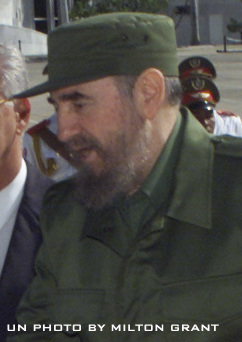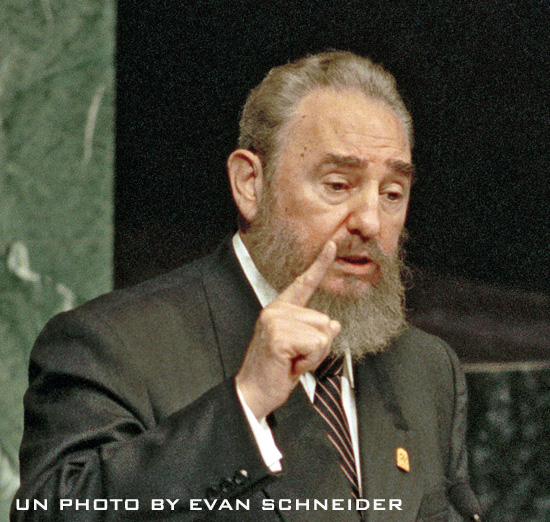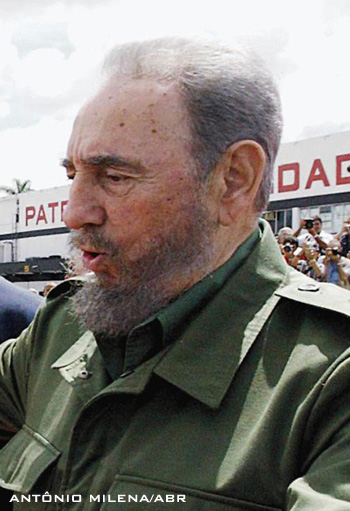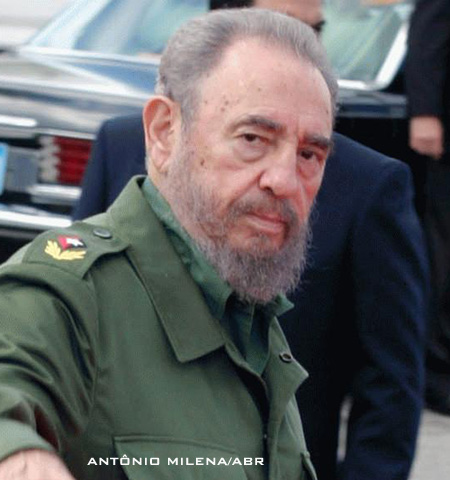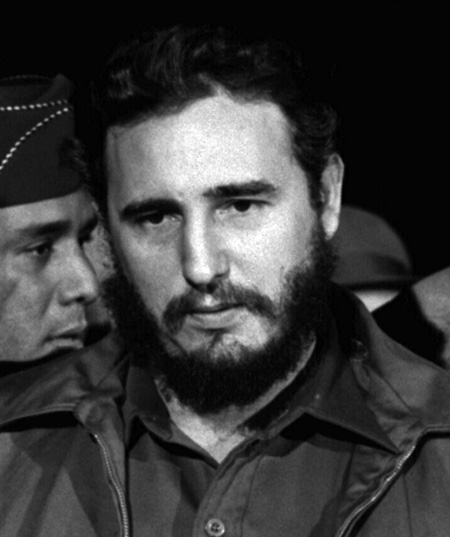Official Stats
- Official Title: Former President
- Government: Communism/Dictatorship
- Years Left in Office: Retired. Kind of.
- Political Classification: Extreme-left
- Education: Law degree from U. of Havana
- Age: 97 (born August 26, 1926)
Fidel Castro Facts and Information
Important Points
- Fidel Castro is a Cuban communist politician who became the leader of Cuba in 1959, the first Communist state in the Western hemisphere.
- Fidel Castro led the overthrow of the Batista dictatorship in 1959.
- Fidel Castro helped lead the Cuban Revolution.
- Fidel Castro brought social reforms to Cuba but was criticized for oppressing human rights.
- During Fidel Castro’s time, Cuba had a resentful relationship with the United States which resulted in the infamous Bay of Pigs invasion and the Cuban Missile Crisis.
- In 2008, Fidel Castro stood down as President and passed on the reigns to his younger brother Raúl Castro, having ruled Cuba for nearly five decades.
The Rundown
Fidel Castro is considered to be one of the most extraordinary political figures of the 20th century. He is a Communist icon who has ruled Cuba for half a century and who turned it from a colonial paradise to a player on the world stage.
A dictator who is only 90 miles from US shore but who has outlived 9 U.S. Presidents and survived 638 assassination attempts by the CIA. The assassination attempts reportedly included cigars poisoned with botulinum toxin, an exploding cigar, a ballpoint pen containing a hypodermic syringe preloaded with the lethal concoction Blackleaf 40, and plain, mafia-style execution endeavors, among others. There were plans to blow up Castro during his visit to Ernest Hemingway’s museum in Cuba. There was even a documentary film entitled ‘638 Ways to Kill Castro.’ Some attempts were made to assassinate his character by using thallium salts to destroying his beard or lacing his studio with LSD so that he would feel disorientated during his broadcast. Castro once said, in regards to the numerous attempts on his life he believed had been made, “If surviving assassination attempts were an Olympic event, I would win the gold medal.”
A tropical paradise spilling with rum, rumba and roulette. This was the Cuba most Americans knew in the 50s but just below the surface the rhythm of revolution was beating. The Cubans wanted to rid themselves of their Spanish colonial masters but U.S. sent troops to fight for Cuba’s independence. America invested capital in the country which led to a nationalist sentiment in Cuba.
PERSONAL LIFE
He was born out of wedlock at his father’s farm in the eastern Cuban hamlet of Birán, on August 13, 1926. Ever since childhood, Castro had a love of weapons, in particular guns, and expressed his preference for life in the countryside over the city. He loved reading Ernest Hemingway. He was a sports fan and spent a lot of time exercising regularly. He took a great interest in gastronomy, as well as wine and whisky, and as Cuban leader was known to wander into his kitchen to discuss cookery with his chefs. However, a book written by one of his bodyguards claims that Castro actually lived quite a luxurious life unaware to the Cuban people. He had several houses and yachts.
Castro has been described as “fiercely hard-working, dedicated, loyal… generous and magnanimous” but noted that he could be “vindictive and unforgiving”. He had a sense of humor but if humiliated he would respond with rage. He felt, from the very beginning, that it was his mission to save the Cuban people.
Many details of Castro’s private life, particularly involving his family members, are scarce as the state media is forbidden to mention them. Castro’s biographer said that he was unable to have a lasting relationship with any female. He had one son from his first marriage and five more from his second marriage. He had extra-marital affairs and fathered children as well.
EDUCATION AND ENTRY INTO POLITICS
In 1945, while studying law at the University of Havana, Castro admitted he was ‘politically illiterate’ and became actively involved in the gangsterismo culture within the University. It was here that he adopted leftist anti-imperialist politics. He openly criticized President Ramón Grau’s government during a public speech in 1946 which caused quite a stir in the media.
In 1947, Castro joined the socialist Party of the Cuban People (Partido Ortodoxo), founded by veteran politician Eduardo Chibás. Chibás wanted an honest government, political freedom and social justice. All these reforms resonated with Castro even after Chibás lost the election and so Castro continued to work on his behalf.
POLITICAL IDEOLOGY
By 1948, Castro had moved further to the left as he began reading more about Marxism and Leninism. He later described Marxism as an ideology that taught him about society and the history of the class struggle without which he felt like a ‘blindfolded man in a forest.’ According to him, Cuba was turning into a ‘dictatorship of the bourgeoisie’ and agreed with Karl Marx’s view that a proletariat revolution was necessary to bring about political change.
CASTRO VS BATISTA
Castro met with General Fulgencio Batista during his campaign to run for Congress in the June 1952 elections. The former President had returned to politics with his own party. In March of that year Batista carried out a military coup and seized power resulting in Carlos Prío, who took over the office after President Grau, having to flee to Mexico. Batista refused to hold elections in June and described his new system as ‘disciplined democracy.’ Corruption increased as Batista felt free to dip into the national treasury. Castro, however, saw it as a dictatorship. Slowly, Batista began to sever diplomatic relations with the Soviet Union while strengthening ties with the US. He suppressed trade unions and persecuted socialist groups within the country. It was then that Castro began to plot ways to oust this regime.
In 1953, Castro planned the overthrow of US-backed military junta of President Fulgencio Batista. He planned an attack on the Moncada Barracks in Santiago de Cuba along with 150 comrades. The goal was to seize enough arms to undertake a military revolution. Despite U.S ties to Batista, the CIA covertly funded Castro’s revolutionaries. The operation failed miserably and many were jailed if not already dead. Among them was Castro whose trial was televised – a big mistake. It gave him the platform he needed to spread his message and capture people’s attention with his stirring oratory. Castro claimed that he was the true defender of the Cuban constitution and that Batista had simply usurped power. From prison, he produced a manuscript of his words, “History will absolve me”. After being released from prison on amnesty, he renamed his group the ‘26th of July Movement’ which soon became a slogan.
ERNESTO CHE GUEVARA AND THE MR-26-7
In 1955, in the midst of bombings and demonstrations, Castro and Raúl fled the country to Mexico where they befriended Ernesto Che Guevara, a Marxist-Leninist just like them who was destined to become the world’s most recognized revolutionary. Once Castro’s rebels had been trained in guerrilla warfare and the 26th of July Movement, otherwise known as MR-26-7, had gained momentum in Cuba, Castro purchased a yacht he named ‘Granma’ and set sail for Cuba to fight for the rights he believed him and his people deserved. They were ambushed by the Cuban army which forced Castro and his men to escape to the Sierra Maestra Mountains where they hid for nearly two years and developed their political strategy and army. Across Cuba, anti-Batista groups carried out bombings to which the police responded with mass arrests, torture and executions. Castro contacted foreign media to spread his message since Cuba’s press was censored and he soon became a celebrity. Meanwhile, his guerrillas increased their attacks on military outposts, forcing the government to retreat.
By 1958, Batista was under tremendous pressure by the people of the country. Batista responded to the MR-26-7 with ‘Operation Verano’; an aerial bombardment of areas suspected of aiding the militants but his army did not stand a chance against the tactics of guerrilla warfare. Many in Batista’s army switched sides including the Commander General who secretly agreed to a ceasefire with Castro, promising that Batista would be tried as a war criminal. However, Batista was warned of this and fled into exile with over US$ 3 million. The Commander General tried to seize power but Castro ended the ceasefire and ordered his arrest. Cubans looked at this as a collective victory.
CASTRO TAKES OVER
As Castro rolled into Cuba, millions of people took to the street to rejoice. He proclaimed himself Representative of the Rebel Armed Forces of the Presidency. As he was giving his first speech, a few doves flew to his shoulder. The white dove, in Cuban religion, is a very significant animal. The people of Cuba saw this as a signal and saw Castro as ‘the Deliverer’ who was going to transform Cuba into a strong nation.
Batista’s government had killed around 20,000 Cubans, and now popular uproar demanded that those responsible be brought to justice. Castro helped set-up many trials, resulting in hundreds of executions that were widely popular domestically but were condemned internationally, particularly by the US. Castro responding by proclaiming that “revolutionary justice is not based on legal precepts, but on moral conviction”.
He was acclaimed by many across Latin America and on February 16, 1959, Castro was sworn in as Prime Minister of Cuba. He didn’t want to admit to being a communist but he had a lot of Marxists in senior government and military positions including the appointment of Che Guevara as Governor of the Central Bank which forced the Air Force Commander to defect to the US. President Urrutia was worried about the influence of Marxism which angered Castro so much that he resigned as PM only to resume his position once a Marxist was sworn in as President. From that day forward, the U.S. objective was now the overthrow of Castro within one year.
Castro began improving Cuba’s standard of living with emphasis on improving the education system. Health care was nationalized and infrastructure was significantly improved. He used radio and television to spread his ideologies. His next move was to redistribute land and continue on with his agrarian reform. What he didn’t realize was that the more he helped improve conditions for the lower class, the middle class began to emigrate from Cuba to the US. Since the middle class consisted of all the professionals in the workforce, this resulted in an economic brain drain in Cuba which led to many counter-revolutionaries and subsequently their arrest. This eventually led to the six-year War against the Bandits.
COLD WAR
By 1960, the Cold War had begun between the capitalist liberal democracy America and the socialist state run by a Communist party, USSR. Alarmed by Castro’s revolutionary credentials and friendly relations with the Soviet Union, the U.S. governments of Dwight D. Eisenhower and John F. Kennedy unsuccessfully attempted to remove him, by economic blockade, assassination schemes and counter-revolution. Having feared a U.S. backed coup for a while, Castro began to double the size of his armed forces.
UNCLE SAM STEPS IN
Then in April of 1961, Eisenhower and Kennedy carried out the Bay of Pigs Invasion. The plan was to train Cuban exiles to invade Cuba and overthrow Castro. Classified documents show that America had hired the mafia to kill Castro days before the invasion. American forces engaged in a firefight with local revolutionary militia but were forced to surrender within three days. This plan was later dubbed ‘The Perfect Failure.’ Castro visited the exiles in jail and used his powers of persuasion to turn their views around in his favor.
The U.S. did not take their failure lightly. President Kennedy encouraged his brother to carry out an ‘ongoing secret war’. This was called Operation Mongoose. It included bombing sugar mills and factories, burning farms, weekly raids in Cuba and supplying guerrillas within the country with arms. This was an example of low intensity warfare. The CIA even went so far as to plotting to frame Castro if NASA’s mercury rocket exploded while in flight.
In August 1961, Richard Goodwin, Kennedy’s advisor, flew to South America for a secret meeting with Che Guevara to broker a deal. Che promised that Cuba would cut down its military ties with the Soviet Union, stop exporting revolution and compensate U.S. companies it had expropriated in the 1960s in return for an end to U.S. involvement in Cuba. Castro had sent a pack of Kennedy’s favorite cigars as a gift. Instead of meeting Cuba halfway, Kennedy took their concessions as a sign of Castro’s weakness ad decided that this was the best time to strengthen their attack.
CUBAN MISSILE CRISIS
Countering these threats, Castro formed an economic and military alliance with the Soviets. Militarily weaker than NATO, Nikita Khrushchev who led the Soviet Union during part of the Cold War wanted to install nuclear missiles on Cuba to which Castro agreed, believing it would guarantee Cuba’s safety and so in October of 1962, nuclear missiles rolled into the country. The U.S. blockaded Cuba and found themselves face to face with Soviet ships. What America did now know was that there were already nuclear weapons on the island. They were later discovered through aerial reconnaissance, thus sparking the Cuban Missile Crisis of 1962.
Castro was convinced that the U.S. would launch a nuclear attack. The U.S. saw the missiles as offensive but Castro insisted they were for defense only. Castro wanted Khrushchev to threaten a nuclear strike on the U.S. in case Cuba was attacked. The world was on the brink of a nuclear war and people everywhere waited with bated breath for the crisis to unfold. However, Khrushchev had no intentions of starting a nuclear war. He knew that U.S. missiles outnumbered them and the Soviet Union had already suffered enough during World War I and II.
Soon after, Khrushchev made a secret agreement with the U.S. to remove the missiles in exchange for a U.S. promise not to invade Cuba and for the removal of their missiles from Turkey. Castro was unaware of this and was furious at Khrushchev. He demanded U.S. to end its embargo and stop violating Cuban air space and territorial waters. The U.S. ignored these demands.
KENNEDY’S ASSASSINATION
Even though the idea of assassinating Castro wasn’t dead yet, another assassination was impending; the assassination of President Kennedy. The day he was shot, his envoy was negotiating with Castro in Cuba but the meeting came to an end when word reached Cuba of Kennedy’s death. Meanwhile, a CIA officer was meeting with a spy in the Cuban military to give him a poisoned pen with which he could kill Castro. The spy was not impressed and left.
CUBAN COMMUNIST PARTY
Castro later visited the USSR and returned with new ideas. Soon after, his mother died and this was the last time that Castro’s personal life was in the news. In the years that followed the Cuban Communist Party was formed and Castro became its First Secretary. He spent the next few years visiting countries like Chile, Panama, Nicaragua and other leftist countries in Europe and Africa to support their governments.
In 1967, while Che was supporting revolution in Bolivia, the CIA hired an exile to kill him. He was captured and executed.
PRESIDENT FIDEL CASTRO
In 1976, Castro became President with Cuba becoming a one-party state under Communist Party rule; the first of its kind in the western hemisphere. Industry and businesses were nationalized, and socialist reforms implemented in all areas of society. He opposed drug use, gambling and prostitution. He wanted people to be hard working and have self-discipline, integrity and respect their family values. Castro proclaimed himself to be “a Socialist, a Marxist, and a Leninist”. He used themes of socialism and nationalism together.
In the years following his presidency, he supported foreign revolutionary groups abroad in the hope of toppling world capitalism, sending Cuban troops to fight in the Yom Kippur War, Ogaden War, and the Angolan Civil War where he helped left-wing government fight South-African backed rebels.
CASHLESS CUBA
By the 1980s, Cuba’s economy was in trouble again. Desperate for money, Cuba’s government secretly sold off paintings from national collections and illicitly traded for U.S. electronic goods through Panama. Many Cubans fled to Florida and this eventually led to a mass exodus of around 125,000 Cubans to the U.S via Mariel port.
In 1985, Mikhail Gorbachev became Secretary-General of the Soviet Communist Party. A reformer, he implemented measures to increase freedom of the press and economic decentralization in an attempt to strengthen socialism. Castro feared that the reforms would weaken the socialist state and allow capitalist elements to regain control. Gorbachev conceded to U.S. demands to reduce support for Cuba, with Soviet-Cuban relations deteriorating. Gorbachev told Castro that he was ending subsidies for Cuba.
SPECIAL PERIOD
Following the Soviet Union’s dissolution in 1991, Castro led Cuba into its economic “Special Period”. This was a time period when petrol rations were dramatically reduced, Chinese bicycles were imported to replace cars, and factories performing non-essential tasks were shut down. Between 1989 and 1993, Cuban economy dropped by a third. To recover from this, Castro brought back tourism and the U.S. dollar. Cuban Americans were allowed to remit dollars to their relatives in Cuba.
In August 1994, the most serious anti-Castro demonstration in Cuban history occurred in Havana, as 200 to 300 young men began throwing stones at police, demanding that they be allowed to immigrate to Miami. Within months, more than 35,000 people left Cuba in flimsy rafts and boats, prompting a migration agreement with the United States to allow a minimum of 20,000 legal entry visas to Cubans annually.
Drowning in economic problems, Castro decided to forge alliances in the Latin American Pink Tide – namely with Hugo Chávez’s Venezuela – and join the Bolivarian Alliance for the Americas in 2006. The alliance boosted the economy.
RAÚL CASTRO TAKES OVER
Castro’s health was worsening quickly from fainting spells at a public rally to smashing his left knee as he fell on the steps of Che Guevara mausoleum to sustained intestinal bleeding. As a result, he transferred his responsibilities to Vice-President Raúl Castro in 2006. Commenting on Castro’s recovery, U.S. President George W. Bush said: “One day the good Lord will take Fidel Castro away”. Hearing about this, the atheist Castro ironically replied: “Now I understand why I survived Bush’s plans and the plans of other presidents who ordered my assassination: the good Lord protected me.”
In 2008, Raúl formally assumed presidency but he continued to consult Fidel on matters of great importance as he described his brother as ‘no substitutable.’ Following his retirement, his health didn’t get any better but he continued to meet foreign leaders. He made a few public appearances and in 2011, he resigned from the Communist Party central committee. Raúl took his place and is currently the President of Cuba.
Photos
Plaidcasts Involving this Leader
- US Screws Self at Summit of Americas Apr 15, 2012
- In Other News…08.06.11 Aug 6, 2011
Translate This Page

